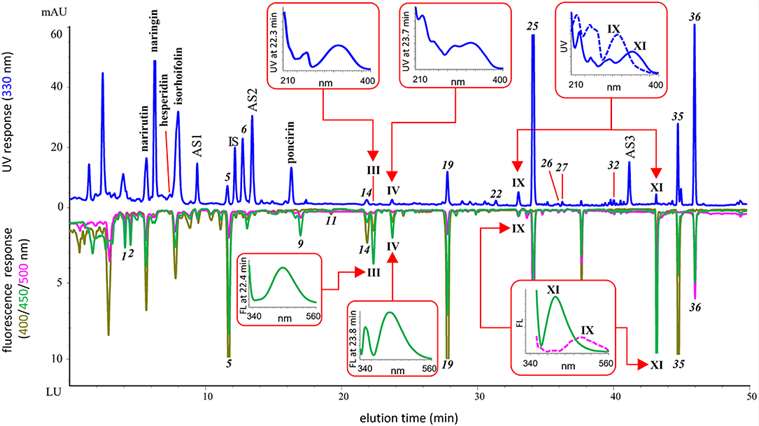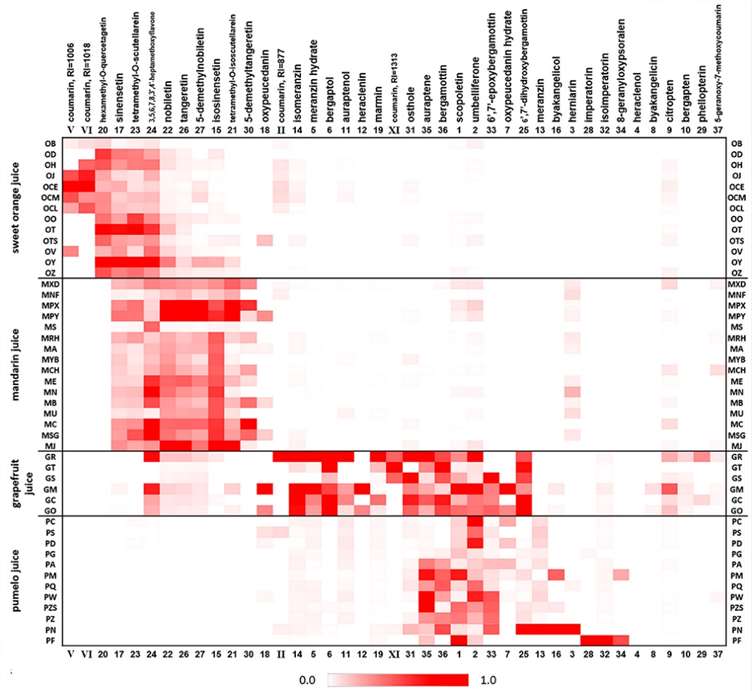Grapefruit, scientifically known as Citrus paradisi, is a widely distributed citrus fruit renowned for its abundant nutritional content and bioactive compounds. Metabolism analysis of grapefruit involves a comprehensive investigation into how the human body processes and utilizes the chemical components present in this fruit. Grapefruit is a common dietary choice, rich in essential nutrients such as vitamin C, dietary fiber, and an array of bioactive compounds, including naringin, hesperidin, and flavonoids. These compounds have garnered significant attention due to their potential health-enhancing properties. The exploration of grapefruit metabolism seeks to unravel the intricate processes of absorption, distribution, metabolism, and elimination of these compounds within the human body.
When grapefruit is ingested, its chemical constituents can interact with various enzymes and transporters located in the gastrointestinal tract and liver. These interactions have the potential to influence the bioavailability of grapefruit compounds. For instance, naringin and other flavonoids found in grapefruit possess the ability to inhibit cytochrome P450 enzymes. This inhibition can have implications for the metabolism of certain pharmaceutical drugs, resulting in what is commonly referred to as the "grapefruit-drug interaction." This phenomenon underscores the significance of grapefruit consumption altering the way the body processes specific medications, potentially leading to unintended side effects or modified drug effectiveness.
Furthermore, certain grapefruit compounds like hesperidin and naringin undergo metabolism by gut bacteria, leading to the production of smaller, bioactive metabolites. These metabolites may exhibit antioxidant and anti-inflammatory properties. Additionally, they can influence the composition of the gut microbiota, potentially impacting an individual's overall health. It is worth noting that grapefruit consumption has been associated with a range of potential health benefits, including improvements in cardiovascular health and the exploration of anti-cancer properties. Nonetheless, it is crucial to recognize that individual responses to grapefruit can vary based on genetic factors, overall dietary patterns, and specific health conditions.
Citrus paradisi (Grapefruit) Analysis Projects We Provide
Metabolite Profiling: We identify and quantify a wide array of metabolites within grapefruit, including sugars, organic acids, amino acids, lipids, secondary metabolites, and volatile compounds, which allows for a detailed understanding of grapefruit's chemical composition.
Nutritional Assessment: Our services determine the nutritional content of grapefruit, including essential vitamins, minerals, and dietary fiber.
Flavor and Aroma Analysis: We analyze volatile compounds responsible for grapefruit's distinctive flavor and aroma, aiding in product development for the food and beverage industry.
Bioactive Compound Profiling: We identify and quantify bioactive compounds like naringin and limonin, which have potential health benefits.
Quality Control: Our metabolomics analysis helps assess grapefruit quality and ripeness, ensuring consistent product quality and freshness.
Medication Interaction Insights: We investigate the compounds in grapefruit that may interact with specific medications, providing valuable information for pharmaceutical research and safety assessments.
Genetic and Environmental Factors: Our services explore how genetic factors and environmental conditions influence grapefruit metabolite composition, aiding in crop improvement and cultivation practices.
Grapefruit Metabolomics Analysis Techniques
Liquid Chromatography-Mass Spectrometry (LC-MS): High-resolution LC-MS instruments, such as the Thermo Fisher Q Exactive series, are used for targeted and untargeted metabolite profiling.
Gas Chromatography-Mass Spectrometry (GC-MS): GC-MS, utilizing instruments like Agilent 7890A-5975C, is ideal for volatile metabolite analysis in Grapefruit.
High-Performance Liquid Chromatography-Mass Spectrometry (HPLC-MS): HPLC-MS systems, including the Agilent 1290 Infinity II, are employed for the separation and quantification of metabolites.
 Workflow for Metabolomics Service
Workflow for Metabolomics Service
Sample Requirements for Grapefruit Metabolomics
| Sample Type |
Sample Size |
Sample Storage |
Sample Preparation |
| Fresh Grapefruit |
10-20 fruits |
Refrigerate at 4°C |
Wash and peel the fruits. Remove seeds and pith. |
| Frozen Grapefruit |
200-500g |
Freeze at -80°C |
Thaw and blend the frozen grapefruit into a homogenous mixture. |
| Grapefruit Juice |
50-100 mL |
Freeze at -20°C |
Centrifuge to remove pulp and debris. |
| Grapefruit Peel |
10-20 peels |
Freeze at -80°C |
Grind the frozen peel into a fine powder. |
| Grapefruit Pulp |
100-200g |
Freeze at -80°C |
Homogenize the frozen pulp. |
Case. Detection of Citrus Juice Authenticity Using Oxygenated Heterocyclic Aglycones and Chemometric Models
Background
The study aims to develop a method for detecting adulteration in citrus juices by analyzing the composition of oxygenated heterocyclic aglycones (OHAs) and applying chemometric models. Adulteration is a concern in the juice industry, where cheaper juices are sometimes mixed with premium ones, compromising authenticity and quality.
Samples
The study included citrus juice samples from four varieties: sweet orange, mandarin, grapefruit, and pomelo. A total of 158 samples from 47 commercial cultivars were analyzed. These samples covered a wide range of citrus juice varieties commonly available in the market.
Technological Methods
1. Standards and Solvents:
- Utilized 39 HPLC-grade standard compounds of OHAs from various sources.
- Prepared stock solutions of individual standards in methanol or dimethyl formamide.
- Prepared a mixture of alkylarylketones at a concentration of 10 mg/L each.
- Used HPLC-grade solvents and produced ultrapure water.
2. Sampling, Juicing, and Thermal Pasteurization:
- Harvested fresh mature fruits from different citrus varieties.
- Hand-extracted juice, fine-filtered, and pasteurized at 100°C for 60 seconds.
3. Fractionation and Extraction:
- Separated juice into clear serum and cloudy solids.
- Extracted solids with acetonitrile and subjected serum to solid-phase extraction.
- Eluted OHAs with ethyl acetate, combined extracts, and redissolved in methanol.
4. Analytical Conditions and Detector Settings:
- Employed HPLC with Poroshell 120 EC-C8 column and Agilent 1,260 system.
- Used DAD and FLD detectors in series.
- Utilized specific mobile phases and detector settings for UV and fluorescence emissions.
5. Identification and Screening of OHAs:
- Identified OHAs by comparing sample peaks to standards using absorbance and emission spectra.
- Employed fluorescence peak ratios, retention index values, and spectral comparisons for identification and screening.
6. Quantitation and Validation:
- Quantitated samples using calibration curves with an internal standard.
- Validated methods with assessments for linearity, LOD, LOQ, repeatability, and recovery using analyte surrogates.
7. Statistical Analysis:
- Conducted ANOVA and Duncan's test on triplicate analyses.
- Employed multivariate analysis (PCA and PLS-DA) for data analysis.
Results
Quantitative Profile of OHAs Among Four Citrus Juices: The study revealed variations in the total amount of OHAs among citrus species, with sweet orange containing <5 mg/L, mandarin averaging 5–10 mg/L, and pomelo and grapefruit ranging from 5 to 100 mg/L. The quantitative results were normalized for each compound across all cultivars, and a heat map was generated to show the relative weight (normalized concentration) of OHAs in each citrus juice.
Identification of Orange and Grapefruit Juices Adulterated by Mandarin and Pomelo Juices: The study developed recognition models using PLS regression to detect adulteration in sweet orange and grapefruit juices when blended with mandarin and pomelo juices. Criteria were proposed for assessing juice authenticity based on the predicted purity (PP) of the juice products.
Detection of Grapefruit Juice Incorporated With Two Categories of Pomelo Juice: Differentiation models were created to detect grapefruit juice adulteration with Shatianyou and Wendan pomelo juices. Criteria for assessing grapefruit juice authenticity were provided, considering the predicted purity (PP) values.
 Chromatograms of identified OHAs.
Chromatograms of identified OHAs.
 Heat map displaying OHAs distribution profile and relative weight in the pasteurized juices of 47 citrus cultivars.
Heat map displaying OHAs distribution profile and relative weight in the pasteurized juices of 47 citrus cultivars.
Reference
- Han, Leng, et al. "Targeted metabolomics with a chemometric study of oxygenated heterocyclic aglycones as a tool for preliminary authenticity assessment of orange and grapefruit juices." Frontiers in Nutrition 9 (2022): 897982.


 Workflow for Metabolomics Service
Workflow for Metabolomics Service Chromatograms of identified OHAs.
Chromatograms of identified OHAs. Heat map displaying OHAs distribution profile and relative weight in the pasteurized juices of 47 citrus cultivars.
Heat map displaying OHAs distribution profile and relative weight in the pasteurized juices of 47 citrus cultivars.

